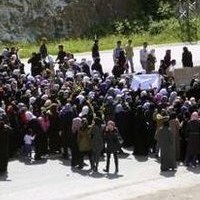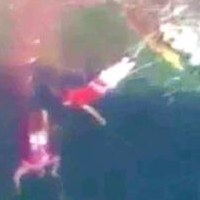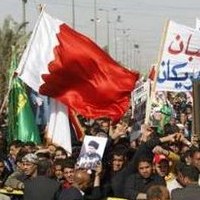![]()
Sun, Feb 20, 2011 | The Meir Amit Intelligence and Terrorism Information Center
Reformist Opposition brings Thousands to Iran’s Streets for first time since 2009 Protests
On Monday, February 14, several thousand demonstrators held protest rallies as planned, despite heavy deployment of the security forces. Organized by the reformist opposition, the rallies were held to show support for the popular uprisings in Egypt and Tunisia, taking place even though they were unauthorized by the authorities.
The reformist opposition had spent more than one week preparing for the February 14 (Bahman 25) demonstrations. Opposition supporters in Iran and elsewhere put considerable effort into recruiting supporters and activists to take part in the demonstrations. Among other things, a dedicated page was created on the social network Facebook to raise support for the protest rallies. Over 55 thousand web surfers showed their support by “liking” the Facebook page.
During the demonstrations, held in several locations in downtown Tehran, demonstrators clashed with security forces. They chanted slogans against the regime, e.g. “death to the dictator” and “Mubarak, Ben Ali, now it’s time for Seyyed Ali [Khamenei]”. Internal security forces deployed across Tehran and blocked roads leading to central squares. According to reformist opposition reports, the security forces used tear gas to disperse the demonstrations and arrested hundreds of protesters. At least two people were killed in the clashes. One of the victims was identified by pro-government media as a student and member of the Basij. Opposition sources claimed, however, that the person killed was an opposition activist. Demonstrations were held in other major cities as well, including Esfahan, Tabriz, Shiraz, Rasht, Ahvaz, and Kermanshah.
In the days leading up to the demonstrations, authorities had stepped up their oppression of the opposition. News websites affiliated with the reformist opposition reported that the authorities arrested several reformist political activists and journalists, including Mohammad Hossein Sharif Zadegan, who was welfare minister in former president Mohammad Khatami’s government. The two opposition leaders, Mir-Hossein Mousavi and Mehdi Karoubi, were even put under house arrest. On the morning of the demonstration, the internal security forces surrounded Mousavi’s house, disconnected his telephone lines, and prevented his wife and him from contacting their supporters or leaving their residence to join the demonstrators.
In addition, the authorities imposed restrictions on texting and web surfing to make it more difficult for the opposition activists to organize for the demonstrations. Iranian bloggers reported that in recent days the word “Bahman” has been added to the list of prohibited keywords used by Iran’s official web filtering mechanisms, making it impossible to use when performing searches on various websites, including the Google search engine (www.irangreenvoice.com, February 11).
Conservative media attempted to play down the extent of the incidents, claiming they were minor, short-lived demonstrations attended by petty criminals and agitators encouraged and supported by Western elements. In the reports, Iran’s conservative media stressed that no calls of support for the popular uprisings in Egypt or Tunisia were made during the demonstrations, and that this proved that the opposition leaders sought only to take advantage of the developments in North Africa to attain their political goals. The conservative media also accused the regime’s opponents of taking down several conservative-affiliated news websites, including Aftab News, Fararu, and Jahan during February 14 (Farda; Fars, February 14).
The conservative website Raja News claimed that the events of February 14 have proven that there is no cause for concern about a possible repeat of the post-election riots in Iran. The website noted that despite ten days of planning and the support of Western media, the regime’s opponents were only able to bring several thousand protesters to the streets of Tehran. The website noted, however, that it is necessary to take advantage of the fact that the two opposition leaders, Mir-Hossein Mousavi and Mehdi Karoubi, have been acting in the interests of the U.S. and Israel to arrest and prosecute them (Raja News, February 14). During a Majles session held on Tuesday, February 15, several Majles members issued a demand to put the opposition leaders to trial, and calls of “death to Mousavi, Karoubi, and Khatami” were even heard in the Majles chamber (Mehr, February 15).
On the eve of the February 14 demonstrations, top Iranian officials and conservative circles once again accused the opposition of collaboration with the West to destabilize the regime. The daily Keyhan claimed that all the opposition leaders wanted to achieve by holding the demonstrations was to express their stand against the regime rather than show support for the struggle of the Tunisian and Egyptian people. In a commentary article, Keyhan’s editor-in-chief Hossein Shariatmadari cited the former director of Voice of Israel in Persian Menashe Amir and U.S. Vice President Joe Biden, who allegedly admitted that the opposition leaders had requested an authorization to hold the rallies under the pretext of supporting the popular struggle in Egypt and Tunisia, when in fact they sought to challenge the regime. It is clear, the daily argued, that the reformist opposition leaders’ intent is not to show support for the anti-American and anti-Israeli uprisings in Egypt and Tunisia, since they proved during last year’s demonstrations that they were acting as a “fifth column” in the service of the U.S., Britain, and Israel. Those who serve the interests of Israel and the U.S. show disrespect for the founder of the Islamic revolution and the sanctity of Islam, receive assistance from the president of the U.S., and collaborate with Iran’s enemies cannot be considered as supporters of the Egyptian uprising. Mousavi and Karoubi clearly knew that they would not be granted an authorization to hold the demonstration after their actions had shown that their identity is neither Iranian nor Islamic. They requested an authorization for no other reason than to take advantage of the latest developments to once again compromise the Islamic republic (Keyhan, February 13).
Meanwhile, Basij chief Mohammad Reza Naqdi claimed this week that Western intelligence services are looking for a mentally retarded person to set himself on fire in Tehran and provoke riots, similarly to what happened in Tunisia and Egypt. Naqdi noted that the intelligence services are insane to believe they can make achievements by copying the events that took place in Tunisia and Egypt. He said that Western intelligence services attempted to do the same during last year’s riots, but the Iranian people identified their actions and took a stand against them (Fars, February 13).



 RSS
RSS











#Reformist Opposition brings Thousands to #Iran’s Streets for first time since 2009 Protests
| #freeiran #25Bahman http://j.mp/f4kD62
Gb SIMI: Reformist Opposition brings Thousands to Iran's Streets for first …: One of the victims was identifie… http://bit.ly/h9ILdp